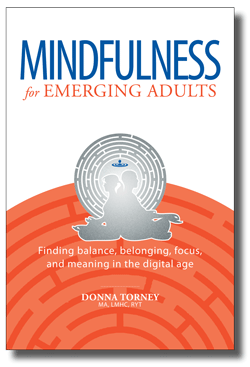Compassion for self and others is essential for building intimacy and community.
Self-compassion and compassion toward others are important social skills. They are the building blocks to forming your own community. Remember that fMRI imaging confirms that compassion-based contemplative exercises make visible changes in the structure of the brain. Self-compassion, as opposed to the ever-popular self-loathing, judging, and comparing are what help us make true, lasting connections to friends and romantic partners.
- In what areas in your life where you are too self-critical or critical of others?
- What would happen if you softened just a bit, toward yourself or toward others?
There are many road blocks that can come between you and the compassion for yourself and others that is necessary to create and sustain meaningful relationships.
- Self-consciousness
- A friend gap
- Lacking a sense of place
- Not knowing how and why to ask for help
- Not understanding mindful communication
- A lack of self-compassion
- Understanding the difference between intensity and intimacy
Learning how to do the following will help you weather the difficult times we all experience:
- Heal a broken heart
- Calm social anxiety
- Stop comparing and begin connecting
- Tame fear of missing out (FOMO)
More information on learning the skills listed above is available from Mindfulness for Emerging Adults by Donna Torney, MA, LMHC, RYT.

Taming Self-consciousness
We’ve all felt it. You’re standing at a party or sitting in a meeting at work, and you just feel like an outsider. You might be thinking: They must have made a mistake when they invited me/hired me/ accepted me. These thoughts and feelings are so distracting that your fight or flight response revs up and you start to have trouble contributing to the conversation. The worst part about this anxious chain reaction is that you feel isolated even though you are in a room full of people.
What can help?
Memorize the four tools listed below before your next social gathering. They will help you tame self-consciousness and encourage genuine, safe, human connection. Just as if you were preparing for an important presentation, practice these tools with a video camera, voice recorder, or trusted friend or mentor.
• Normalize. When the demons of self-consciousness take over, we tend to have thoughts like: What is wrong with me? Why can’t I just relax? Although everybody’s nervous system is wired differently, all humans are social animals, and social connection is vital for our well-being. Did you know that the area of the brain that registers social rejection is very near the area of the brain that registers physical pain? Ouch! That is why social rejection can feel so threatening. We learn to protect ourselves from any pain, even imagined pain. If you are somebody who has experienced social rejection in the past, as we all have, you might be on guard for the next attack at a party or at work. One of the best ways to tame this misfiring of the nervous system is to bring awareness to the chain-reaction, and correcting the internal dialogue. You might try repeating a phrase like, “Just like me, everyone here wants to be accepted. Just like me, they might feel a little nervous.” This kind of normalizing self-talk helps heal and re-wire the brain.
• Picture the face of a trusted being. When you find yourself in a stressful social situation, take a few deep breaths, and picture the face of someone you feel entirely comfortable with, someone with whom you can be your true self. This might be an old, dear friend, a family member, or a pet. For some of us this may be the face of a spiritual mentor. Get into the habit of picturing your trusted being before your social event.
• Get curious. Trust in the odds that others around you are feeling like outsiders as well. Try switching your focus toward someone else. Is there someone around you who might benefit by being drawn out? Get curious about someone near you. Ask a question about their day. What are they planning to do to relax this weekend? If this person seems nervous, take a deep breath and drop your shoulders, which will encourage them to do the same. Take the focus off of your own stress, and offer someone else the gift of your kind attention.
• Balance your external desire to impress with your internal intention to connect. A young lady I work with is a flutist. She, like most musicians, sometimes struggles with performance anxiety. After a particularly miserable performance where she was plagued with self-consciousness, she came close to giving up performing all together. She was scheduled to perform the following week, and to her surprise, this performance went much better and she was able to enjoy the process. When I asked what had changed, she said, “Well, I decided that I prepared the best I could with the time I had. Even so, I can’t control others’ reactions, so I decided to focus on what I want to express, which is my love of music.” Her internal value of sharing her love of music outshone her external desire to impress. What values do you want to carry in your pocket in social situations?
Normalizing feelings, picturing the face of a friend, getting curious, and being clear about what you want to express versus how you want to impress: Practicing these four tools will help you feel less self-conscious and more connected.
My heart is broken and I’ll never be okay again!
You are not alone! If you have recently experienced the loss of a love, mindfulness can help you through the healing process. Here are just a few suggestions to help you on your road to feeling whole again. These techniques will help you get back out there in the world where you can exercise your self-compassion and compassion for others and use your experience to further build your community.
• The pain of a broken heart may come in waves –You may feel intense feelings of grief over the next few days and weeks. Know that these feelings are a normal part of the healing process. Think of them as a bitter medicine that you must take in small doses to feel better. Watch as the waves of sadness, shock, anger, shame, and feelings of rejection rise, have a peak, and then disappear. Trust in the fact that this is a form of healing,and these emotions have a beginning, middle, and end. Notice the peace and stillness that comes after they pass. Practicing a series of long slow inhales,followed by slightly longer exhales will help calm your nervous system as you work through these waves.
• Treat yourself like you have the flu – There’s a physiological reason you may feel like you were punched in the gut. Did you know that the area in the brain that is active when we are experiencing physical pain overlaps with the area that is active when we experience social rejection? Attend to the physical manifestations of a broken heart by taking long walks, or start a totally new exercise routine. It is important to balance your waves of pain with some healthy distractions like exercise, moderate amounts of sleep, and a healthy diet. Take some time to outline a new but gentle physical routine for the first few weeks of healing.
• Don’t isolate yourself – The temptation to hide in your room might be strong, especially if you and your ex-beloved shared the same group of friends. Make attempts at connecting with new people. If you are in school,consider joining a new club. Explore community projects that might need your help. Helping others who are in need will restore your sense of self-worth. Building compassion for yourself as well as others is at the heart of mindfulness and healing. Think of three ways you can connect with others to avoid isolation. Write them in your centering journal.
• Don’t self-medicate – Healing requires taking scheduled breaks in the day to monitor your breathing and your thoughts and these breaks will prevent your break-up from becoming a full-blown downward spiral. By coming back to the breath and the body in an intentional way several times throughout the day, you can be curious about any destructive cravings you may have, instead of giving into them. What go-to unhealthy behaviors do you want to try to avoid while you heal? Write about them in your journal. Celebrate your successes.
• Limit your social media use – If you see pictures of the one you long to see every time you go on social media, this will prolong your pain. Consider limiting your social media use. Use a phone, email, or voicemail to make plans with friends. Journal about what would help you avoid social media during this time.
• What was missing? – As you start to heal from your break-up you may start to see that you were not getting all your needs met in the relationship. Now is a good time to take a look at your values and deeply held desires. What is it that you hold most important in your life? What steps can you take to incorporate your values in your life in an intentional way? Set a timer for five minutes. Focus only on your breath, then grab your centering journal and free-write about where you want to be in one year.
• You are not alone! – One of the great outcomes of mindfulness is growth in the understanding that we are all connected – that we are not so different from everyone else. Heartache is part of the human condition and none of us is immune to this fact. Mindfulness reminds us that this condition is temporary. Stay connected with family, good friends, or mentors who can help you heal your heart and reconnect with your true self. What aspects of your true self were put on the back burner during your relationship? What activities do you want to try that reflect your true nature?
• What have you learned from your journey? –Mindfulness helps us learn from our mistakes. Trust in the fact that mindfulness engages the more rational side of the brain, helping you to move forward with clear intention. How will you use mindfulness to heal your heart?(Some examples: Gentle yoga, guided relaxation, bringing your thoughts back to the present.) Another good way to solidify a lesson is to share your hard-won wisdom with a good friend who is experiencing a broken heart. Listening to another’s pain is an act of compassion and will help you to continue to heal.
Excerptedfrom Mindfulness for Emerging Adults byDonna Torney, MA, LMHC, RYT.

 Mindfulness has been a hot trend this year. We hear all kinds of inspiring stories about how folks have used this ancient tool to become a better employee, student, partner, and person. Since the scientific community has become interested in mindfulness and other age-old contemplative arts, studies have proven the value of the ability to be fully present in what you do.
Mindfulness has been a hot trend this year. We hear all kinds of inspiring stories about how folks have used this ancient tool to become a better employee, student, partner, and person. Since the scientific community has become interested in mindfulness and other age-old contemplative arts, studies have proven the value of the ability to be fully present in what you do. Most researchers define mindfulness to include these two main components:
Most researchers define mindfulness to include these two main components: